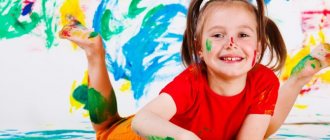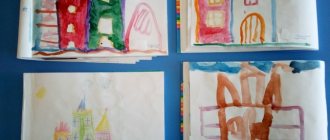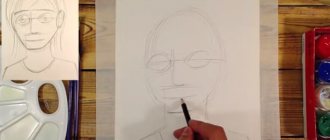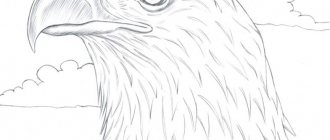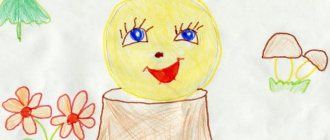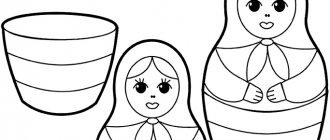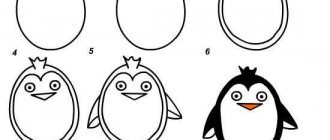Miroshina Elena
Notes on drawing in the preparatory group “Portrait of a Friend”
Municipal budgetary preschool educational institution
kindergarten No. 27 “Fairy Tale”
Summary of GCD for drawing in the preparatory group
«Portrait of a friend»
for RMO for artistic and aesthetic development
Prepared by : teacher Miroshina E. S.
1 sq. category.
Urban district city of Vyksa.
2017
Goal: Formation of interest in portraiture ,
as one of the genres of fine art.
Tasks:
1. Strengthen the ability to draw a portrait of a friend , conveying the features of appearance.
2. Develop figurative perception, visual memory.
3. Cultivate friendly relationships in the group .
Methodical techniques: motivational moment - game “Compliments”
portrait modeling portrait execution scheme (for those who find it difficult, artistic expression, reflection.
Integration of educational areas: artistic and aesthetic development, speech development, social and communicative development, cognitive development.
Preliminary work:
Examination of portraits of famous artists: V. A. Serov “Girl with Peaches”
, V. M. Vasnetsov
“Alyonushka”
, conversations on the painting,
drawing “Daddy’s
Portrait ” , excursion to the museum.
Material:
Benefit "Face"
(consists of an oval and a circle (face, several types of hairstyles (male and female), 4 pairs of eyes (brown, blue, green, gray, pairs of ears, nose (2 types), lips
(3 types)
. Parts of the face are cut out of colored cardboard, displayed on a flannelgraph, sheets of white paper (A4 formats, simple pencils, erasers, water jars, watercolor paints, brushes No. 2, No. 4, napkins, musical accompaniment: audio recording of A. Vivaldi “The
Seasons”
.
On the topic: methodological developments, presentations and notes
Plan outline of an open lesson: Portrait of a friend. (2 ml. Cockerel teacher Babenko E.V.) Program content: Analysis of the depicted train with completed and unfinished carriages, mastered.
Formation of skills to determine emotional states using pictograms. Fostering humanism, “responsiveness”, a caring attitude towards people of different nationalities, a desire to please them with good deeds.
The main goals of this quiz are: - to consolidate children’s knowledge about fire safety rules, rules of conduct in case of fire; - to foster a sense of responsibility; - to develop confidence.
Summary of a lesson on emotional development for children of senior preschool age.
Lesson from the series “Emotional development of preschool children.”
Summary of the sports festival “Towards each other” for children of primary preschool age with their parents. .
- teach children to see each other’s mood; - teach children to look for a way to please a friend; - “Doing something nice for each other” is accepted as a rule, which everyone in the group adheres to.
Source
In the preparatory group of the preschool educational institution
How to teach a child in kindergarten to draw a portrait of his mother. This question concerns not only parents, but also kindergarten teachers. The word “mother” is one of the most ancient on earth and sounds almost the same in different languages of the world. Before doing the work, the teacher conducts a conversation with the children. Has anyone heard how the word “mother” sounds in different languages? All people honor and love their mothers. Many countries celebrate Mother's Day, and Russia also celebrates this holiday.
Note! People congratulate their mothers, come to visit them, give them gifts, sit down together at the festive table and try the food prepared by their mothers.
Preparatory group of preschool educational institution
Scheme for drawing a portrait in the preparatory group
Before choosing a drawing method in the preparatory group, you need to take into account the age of the kids. The software content consists of the main stages:
Vocabulary work: Portrait, chest-length self-portrait, miniature, profile, full face, full face, cheerful, friendly, executive, long-haired, short-haired, white-faced, chubby, black-browed, big-eyed, blue-eyed, brown-eyed, etc.
Didactic game, mood: “Which one is my mommy?” The teacher informs that today they will draw a portrait of a person.
If you see one of us looking from the picture,
Or a prince in an old cloak, or some kind of steeplejack,
A pilot or a ballerina, or Vovka, your neighbor.
The painting must be called ..... (portrait)
What types of portraits do you know? (children's answers)
There are portraits: (showing portraits)
Note! The teacher asks what type of art the children know (still life, landscape). Next, kids should name how to distinguish each type of art from each other? Still life from a landscape? Landscape from a portrait?
Children must guess what they will use to draw the portrait.
“Who loves you children dearly?
Who regrets, who kisses,
Who cares, caresses
Gently rocks you in your arms,
Takes you to kindergarten in the morning”?
Template for drawing a portrait of a mother for children
To make the children's picture beautiful, the teacher provides a template. Children perform all actions for their teacher. Initially, you need to outline the head template. Then you should outline the eye template.
Note! The teacher shows the “eyelids” on himself, tells how to draw correctly: there is an arc from corner to corner from the bottom of the eye.
Instilling a love of art in children in the middle and senior groups is not difficult at all. For this purpose, the teacher must present the material correctly, that is, choose the appropriate topic.
Source
Step-by-step drawing of a portrait of a person with a pencil for children
Very often, little artists draw the human skeleton and muscles. Ignorance of human anatomy can lead to mistakes. That is, movements and facial expressions will look unnatural. Therefore, you need to carefully study the basic principles in order to get a quality drawing. The following stages of drawing a high-quality portrait for children are discussed here.
Important! To facilitate the process, it is necessary to draw a vertical line exactly in the center, which will divide the portrait into two parts, and horizontal lines, dividing it into three parts (forehead, eyebrows, eyes, mouth, nose, chin).
On the top line you should draw arched eyebrows. The eyes should be located below. To give the shape of the eyes, it is necessary to draw arched lines. The middle is for the pupil and iris. After this you need to draw eyelashes. The nose is drawn in the middle (a smooth arched line starts at the eyebrows). You should round off the top of the nose, and then you will have to draw the wings of the nose and nostrils.
Another step by step is drawing the mouth. A line of the mouth and two arcuate lines are drawn (on top of the upper lip). Then the lower lip is drawn with a large arched line. After this, you need to draw the ears and finish drawing the shoulders and hair.
Step by step drawing of a person
In older groups of kindergarten
Many parents wonder how to teach their child to draw a portrait of a person step by step. Initially, the child must be sent to a preparatory preschool center, where professional artists teach all the rules. If it is not possible to send your child to preparatory school, then you need to take him to kindergarten. In all senior groups, children take a drawing lesson.
Note! The teacher teaches how to draw a pencil portrait. Thus, the child will be able to convey the appearance, character and mood of a particular person. Consequently, there is an interest in the search for visual means.
The artist conveys the oval shape, hairstyle, hair color and other facial features. To create a high-quality drawing, a professional artist will be able to depict a person’s character on paper. Next, the teacher asks whether the children want to become real artists? Will they be able to create a unique drawing, for example, to depict their beloved mother?
Scheme for drawing a portrait for older children
The children learn to position the parts of the face correctly. During the course of the work, drawing techniques are consolidated using various materials. The main task of the teacher is to cultivate a feeling of love and respect for the mother. In addition, children are introduced to the public holiday “Women’s Day”.
The drawing should show the mother's facial features (eyes, nose, lips, hair). When creating a picture, children develop an attentive and respectful attitude towards their mother. The child strives to please and help his beloved mother.
Methods of drawing a portrait in the senior group
Before starting this process, the teacher invites the children to familiarize themselves with the material that will be useful for creating the picture. Step-by-step drawing of a mother for older preschoolers involves the use of paper, pencil, wax chalk, watercolor, palette, thick and thin brushes, water glasses, and napkins.
Important! Initially, children look at portraits of famous artists and poets. Next, the guys read literature on the topic “My Mother.”
Progress of the lesson:
“We Divide Everything in Half” plays
.
Educator: My friends, do you think I’m in a good mood? How did you guess? I want to give it to you. the “Cube of Emotions” in my hands
, I found the
“Smile”
, look.
Now, please take each emotion cube and find the happy emotion. Now send each other a cheerful and good mood. Game "Take and Smile"
.
We charged each other with a good mood and cheerful smiles.
Do you know how to guess other people's moods? Now I’ll check if you really know how to guess other people’s moods. Look, here on the board there are pictures depicting people in different situations and with different emotions. Why do you think the people in these pictures are so different? (Because they have different moods and this changes their facial expressions)
. What happens to eyebrows when we are angry or happy? When are we afraid of something, surprised, angry? What can we say about lips? How does the mouth express our emotions, our mood? A conversation is taking place. What mood are the children shown in the picture? Why sad? That's right, the children have a sad face because their mother is sick. Show a picture of a happy face. Why are children happy? The children came to their friend's birthday party. Show a picture with an angry face, with a surprised face. “Well done guys, you can really guess what mood another person is in by their face.
Rules for constructing a portrait
You can draw a profile or full face using any available means. You can use pencil, ink, charcoal, felt-tip pen, watercolor, pen, etc. Each technique gives its own effect depending on the characteristic abilities and the technique used.
Note! To complete the drawing, you need to prepare white or colored, smooth or rough paper. Alternatively, you can use cardboard.
When drawing a person’s face, you should draw the center lines correctly. Using two guides, you can easily highlight the correct proportions, identical eyes, and symmetrical parts. By visually representing these lines, you can work on a person’s facial expressions and emotions. When creating a portrait, you need to show sadness or joy. In the first option, the young artist will have to lower his eyebrows, as well as the corners of his mouth, then close his eyes.
How to teach a child to draw a portrait
This artistic activity is not only a reproduction of the features of a certain person, but an understanding of his inner world. By drawing a portrait of a person, a child conveys his character, appearance, and facial expression. No other genre reveals the genre of painting as much as portraiture.
How to teach your child to draw a portrait correctly
Drawing a portrait step by step for children uses simple pencils. Initially, the child creates his own creation with the simplest lines, blots. Over time, he gradually masters artistic skills. Children under 3-4 years old cannot complete complex tasks because they do not understand proportions well. They have a penchant for creating landscapes and illustrations. But over time, no one forbids drawing portraits of fathers, mothers, grandmothers, grandfathers or other relatives in kindergarten.
On the topic: methodological developments, presentations and notes
Plan outline of an open lesson: Portrait of a friend. (2 ml. Cockerel teacher Babenko E.V.) Program content: Analysis of the depicted train with completed and unfinished carriages, mastered.
Program content: Give an idea of the portrait genre; develop in children the ability to look at human faces; learn to draw a portrait of a friend, correctly depict his facial features; development
Using game techniques and drawing a portrait of a friend with colored sand, this lesson involves the formation of a holistic attitude towards the personal qualities necessary for friendship.
GCD for drawing a person.
Program content: - Continue to introduce children to the “portrait” genre of painting - Make children want to draw a portrait of a friend, convey in the drawing some features of his appearance (eye color.
Summary of continuous educational activities in the artistic and aesthetic direction for children of preparatory age for school on the topic “Portrait of a Friend” at the GBDOU for children.
This material is intended for teachers of older groups.
Source
Step-by-step technique for drawing a portrait of a mother for children
Almost every child loves to draw from an early age. This exciting activity will help children show their talent in art. Little artists perceive their surroundings in their own way. Thus, they convey on paper the most complex and significant genres of fine art. Many children are attracted to portrait drawing from an early age. With proper presentation of the material and proper training, you can boast of a good result.
Lesson notes for the senior group “Portrait”
Tatyana Mikhailovna Klyukova
Lesson notes for the senior group “Portrait”
Abstract
OOD drawing in the senior group on the topic : “ Portrait ”
Klyukova Tatyana Mikhailovna
Teacher of MBOU Secondary School No. 20 DG
Abstract
Classes in the senior group on the topic : “ Portrait ”
Goal: Develop emotional responsiveness.
Learn to understand the emotional state and mood of people around you. Continue to develop the ability to draw a portrait , trying to convey the features of appearance, character and mood of a particular person. Develop an interest in searching for visual and expressive means. Learn to portray a person’s emotions in various situations (broke a cup, bought a doll)
. Cultivate emotional responsiveness. Cultivate a friendly attitude towards each other.
recording of the song “We Divide Everything in Half”
Words: Mikhail Plyatskovsky Music: Vladimir Shainsky
